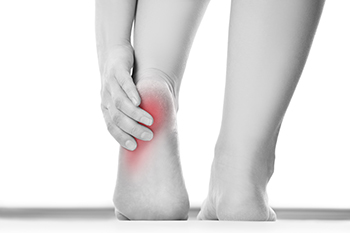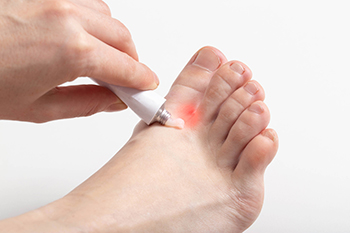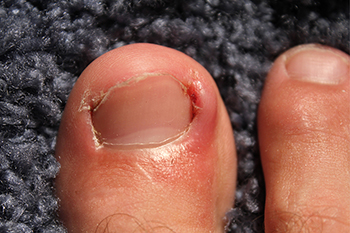Items filtered by date: November 2023
What Is Black Heel?

Black heel is a minor injury that often appears on the heels of teenagers and young adults who play active sports like basketball, football, and tennis. It looks like a group of small, dark spots on the back or side of the heel, right where the heel's fat pad is. These spots are tiny areas of bleeding under the skin. They happen because of the quick, hard contact the foot makes with the ground or floor during sports, which pinches the skin. Most of the time, black heel does not hurt and may not even be noticed unless someone sees it by chance. If you or your child develops black heel, it is suggested that you make an appointment with a chiropodist who can distinguish it from being melanoma or a more serious skin problem.
Injuries to the foot and ankle are very common among athletes. If you have experienced an injury, please consult with Chiropodist Stephanie Poupore from North Bay Foot & Ankle. Our clinician will assess your condition and provide you with quality foot and ankle treatment.
Common Injuries Among Athletes:
Achilles tendon injuries
Ankle strains or sprains
Plantar fasciitis
Fractures
Turf toe
Joint dislocations
Sever’s disease
Morton’s neuroma
Symptoms
Symptoms will depend on the cause and severity of the injury. Common symptoms for a foot or ankle injury include pain, swelling, tenderness, bruising, a reduced range of motion, and difficulty bearing weight or walking on the affected foot or ankle.
Diagnosis
Sports injuries are typically diagnosed after carefully examining the affected foot or ankle. This includes moving the injured area to test its range of motion. Medical history will need to be provided, as well as detailed information about how the injury occurred. Imaging studies, such as X-rays or MRIs, may be used to confirm or rule out certain diagnoses.
Treatment
Just like symptoms, treatment will depend on the type of injury and its severity. Initial treatment for many sports injuries is aimed at controlling inflammation and promoting the healing response. The acronym R.I.C.E is a helpful guide to implement for most acute injuries. This method involves resting, icing, compressing, and elevating the affected foot or ankle. In addition, anti-inflammatory medications may be administered and orthotic devices may be prescribed. For more severe injuries, surgery may be required. Lastly, rehabilitation or physical therapy may be needed to gain full functionality in the afflicted area.
If you have any questions, please feel free to contact our office located in . We offer the newest diagnostic and treatment technologies for all your foot care needs.
Foot Problems That Can Emerge in Springtime

As spring arrives, people often engage in more outdoor activities like running, hiking, and other sports, which can put additional strain on the feet, and potentially lead to various foot problems. Warmer weather may create a moist environment inside shoes, providing a breeding ground for fungi that cause conditions such as athlete's foot. Increased physical activity can also lead to plantar fasciitis, a condition characterized by heel pain due to inflammation of the plantar fascia. Wearing poorly fitting shoes may cause friction that results in blisters. The rise in physical activity also means a greater risk for sprains and strains. If foot problems plague you in the spring season, it is suggested that you make an appointment with a chiropodist for a proper diagnosis and treatment.
Springtime is the season that many people use to get back into exercising and sports. It’s also a time when foot and ankle injuries may be more common. If you have a foot or ankle injury, please consult with Chiropodist Stephanie Poupore from North Bay Foot & Ankle. Our clinician can help you maintain the health of your lower limbs and your mobility.
Common Foot and Ankle Problems in Spring
Plantar fasciitis
Achilles tendonitis
Shin splints
Strains
Sprains
Fractures
And more
Avoiding Injury
Increase physical activity slowly and gradually
Wear comfortable, well-fitted shoes and socks
Take time to rest following a workout
Recognize and treat any injuries promptly
Treatment at Home
Rest the injured foot
Apply ice to reduce swelling
Compress the injured foot with a bandage
Elevate the foot to prevent swelling
Serious, chronic, or particularly painful injuries require medical care by a professional. If you have any questions, please feel free to contact our office located in . We offer the newest diagnostic and treatment technologies for all your foot care needs.
Athlete’s Foot and Its Treatment

Athlete's foot is a fungal condition, scientifically termed tinea pedis, that predominantly targets the feet's skin. It earns its moniker from its frequency among athletes, who are prone to damp footwear conditions, yet it is an ailment that can affect anyone. The responsible pathogens, known as dermatophytes, flourish in the dampness of shoes, shared showers, and sports gear. Those with the infection often endure a rash that not only scales but also itches, burns, and stings, with the skin between the toes being particularly susceptible to peeling and cracking. The condition is communicable and spreadable through both direct skin contact and through shared surfaces like floors or towels. To initially treat athlete's foot, antifungal treatments are typically prescribed. Preventive measures include maintaining dry feet and impeccable hygiene. Without appropriate treatment, the infection can invite more severe bacterial complications, a significant risk for people with compromised immune systems. If you suspect you have athlete’s foot, it is suggested that you make an appointment with a chiropodist for a proper diagnosis and treatment options.
Athlete’s foot can be uncomfortable and unsightly. To learn more about preventing and treating this condition, please consult with Chiropodist Stephanie Poupore from North Bay Foot & Ankle. Our clinician will assess your condition and provide you with quality foot and ankle treatment.
What Is Athlete’s Foot?
Athlete’s foot refers to an infection of the skin on the feet that is caused by a fungus. This fungus is contagious and thrives in warm and moist environments. It is often spread in common areas such as public pools, locker rooms, and showers. It can also spread when sharing personal items, like shoes or towels, with an infected person.
Symptoms
The symptoms of athlete’s foot may include:
Itching, stinging, or burning of the skin on the feet
Cracking or peeling skin, especially between the toes and on the soles of the feet
Scaly, red rash on the foot
Blisters
Foul odor
Treatment
Treatment for athlete’s foot typically involves using over-the-counter topical antifungal medications on the feet. When over-the-counter options are ineffective, you may need to take prescription oral medications or topical antifungal drugs, or a combination of both.
Prevention
Preventing athlete’s foot places an emphasis on good foot hygiene practices.
You can prevent athlete’s foot by:
Washing and drying your feet thoroughly every day
Wearing shoes when walking in public areas
Not sharing personal items, like shoes or socks, with others
Wearing shoes and socks made out of breathable materials
If you have any questions, please feel free to contact our office located in . We offer the newest diagnostic and treatment technologies for all your foot care needs.
Wounds That Don't Heal Need to Be Checked
Causes of Ingrown Toenails

An ingrown toenail, or onychocryptosis, affects people of all ages, disrupting daily activities. It occurs when the nail, due to its natural shape or improper care, grows into the surrounding skin, causing inflammation and potential infection. The nail's growth pattern, influenced by its originating area called the nail matrix, plays a significant role. Specifically, curved or wide nails increase the risk of ingrowths. Other causes can include improper nail trimming, wearing tight shoes, nail picking, and foot injuries. It can progress to an infection if symptoms include redness or warmth, and the presence of pus. If you have an ingrown toenail, it is suggested that you schedule an appointment with a chiropodist who can guide you toward correct treatment methods which can help to restore comfort.
Ingrown toenails may require medical attention. If you have significant pain or notice signs of infection from an ingrown toenail, please consult with Chiropodist Stephanie Poupore from North Bay Foot & Ankle. Our clinician will assess your condition and provide you with quality foot and ankle treatment.
What Is an Ingrown Toenail?
An ingrown toenail occurs when the edges of a toenail grow into the surrounding skin. The toenails of the big toe are usually affected, however, an ingrown toenail can happen on any toe. Sometimes, the area can become infected leading to potentially serious complications. The ingrown toenail may be caused by improper trimming of the toenail, wearing ill-fitting shoes, or injury to the nail.
Symptoms
The symptoms of an ingrown toenail include:
Pain
Swelling
Redness
Warmth
Pus or drainage from the affected nail or a fever may indicate an infection of the area.
Treatment
Treatment depends on the severity of the ingrown toenail. In less severe cases, home treatment may be adequate. Soaking the affected foot in warm water and gently lifting the nail from the skin with a piece of clean cotton can help. In more severe cases, you may need to use topical or oral antibiotics to treat an infection. Surgical removal of the ingrown toenail may be required if more conservative treatments fail.
Ingrown toenails may be prevented by wearing well-fitted shoes and properly trimming the toenails. Toenails should be trimmed straight across and not too short when using nail clippers.
If you have any questions, please feel free to contact our office located in . We offer the newest diagnostic and treatment technologies for all your foot care needs.

